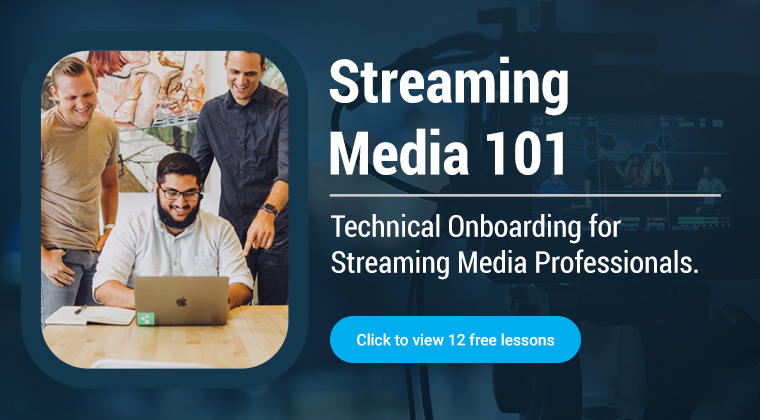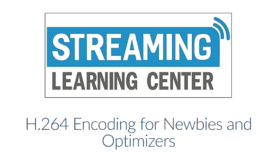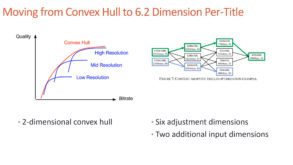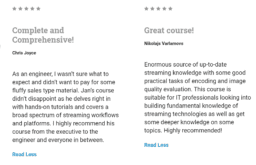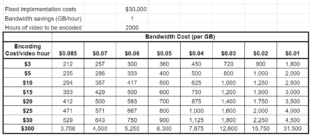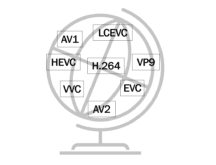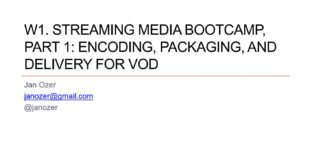The webinar is over; thanks to all who registered and attended. You can watch the recorded version below. The handout is available here. Description: This free webinar teaches streaming media novices how to produce high-quality H.264 output delivered via efficient encoding ladders that optimize quality, compatibility, and bitrate efficiency. The webinar will also introduce the concept of per-title encoding and …
Read More »Lesson of the Week: Per-Title Encoding in 6.2 Dimensions
Engineer and IT Professional Recommend Streaming Media 101
Happy to share two new five-star reviews for Streaming Media 101, the only online training course available for onboarding new streaming media professionals, whether coming from the IT discipline or via engineering. Engineer Chris Joyce commented, As an engineer, I wasn’t sure what to expect and didn’t want to pay for some fluffy sales-type material. Jan’s course didn’t disappoint as he …
Read More »Computing Breakeven on New Codec Deployments
This article and the associated Google Sheet present an analytical model for computing breakeven on new codec deployments. On a LinkedIn post here, Johan Skaneby asked: Technical comparisons and documentation on different codec performance are very interesting and important, but all development of technologies are always closely related to market requirements and business models. My experience is that the challenge …
Read More »Bitmovin Licenses Training Content from the Streaming Learning Center to Include in Internal LMS
Bitmovin (https://bitmovin.com/) has partnered with Jan Ozer, a recognized expert in streaming media and encoding, to provide its new engineering and solutions employees with his Streaming Media 101 course (https://courses.streaminglearningcenter.com/). The course–which has been fully integrated into Bitmovin’s internal learning management system–provides industry-specific content that helps new Bitmovin employees quickly and seamlessly ramp up to full productivity in their technical …
Read More »Video Camera and Webcam Framing for Live and VOD Productions
Framing is the act of placing the subject within the camera frame. Do it correctly and the video looks just like your viewers are used to seeing on TV. Mess up here and you compromise the quality of your video from the start. This 12:42 video teaches you artistic fundamentals like rule-of-thirds positioning, head, look, and lead room, and definitions …
Read More »Beginner’s Guide to Codecs
This post provides an introduction to video codecs. It’s an entry-level article designed to help streaming newbies understand what codecs are, what they do, how to compare them, and why they succeed or fail. Video codecs are compression technologies that reduce the bitrate of digital video to manageable sizes. Video codecs are not only central to streaming, but they’re also …
Read More »Beginner’s Guide to Buying a Camera for Live Streaming
This post discusses factors to consider when choosing a camera for four types of live events. It’s adapted from training materials prepared for a live streaming boot camp I’m producing at Streaming Media Connect on Tuesday, February 23: 11:00 a.m. – 2:00 p.m. (ET) / 8:00 a.m. – 11:00 a.m. (PT). I’ll be releasing a course on live streaming by the …
Read More »Presentation Handouts
There are the handouts from the last few Streaming Media Events. They’re typically long and very detailed, so provide a lot of data and other information. I’ve segmented them by subject and included the videos where available. I hope you find this information useful. Production and Delivery FFmpeg Visual Quality Metrics Per-Title Encoding Hardware Transcoding Production and Delivery Streaming Media …
Read More »VVC to Have At Least Two Patent Pools (Access Advance and MPEG LA)
As I recently reported in Streaming Media magazine, the 49 VVC IP owners assembled by the Media Coding Industry Forum (MC-IF) have chosen two patent pool administrators to form VVC-related pools; Access Advance and MPEG LA. While this is undoubtedly a positive step, it’s merely the first step towards clarifying how much it will cost to license VVC. As previously …
Read More » Streaming Learning Center Where Streaming Professionals Learn to Excel
Streaming Learning Center Where Streaming Professionals Learn to Excel

